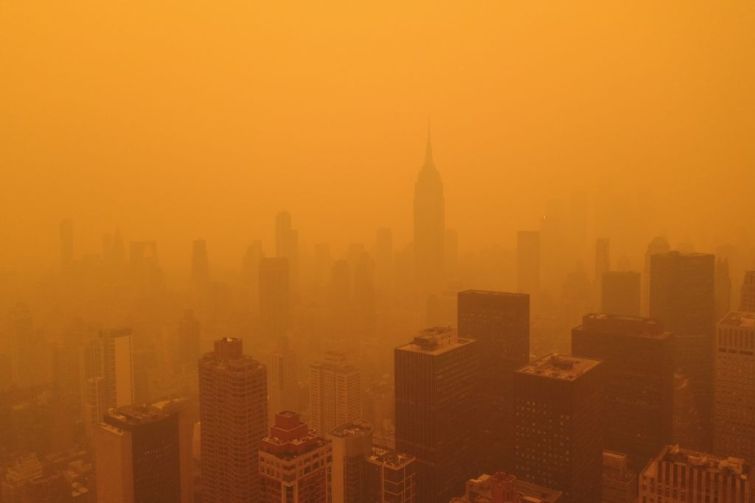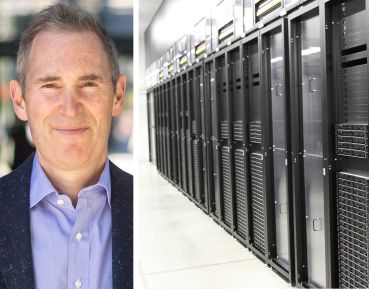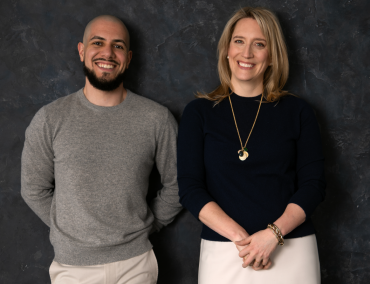For Indoor Air Quality Tech, What Happens When the Outdoor ‘Fresh Air’ Is Bad?
Proptech firms and building owners confront a quirky post-COVID reality when it comes to filtration and other mitigation
By Philip Russo May 14, 2024 10:30 am
reprints
Everyone wants the best air quality in their office and home, but what happens when the outside air is as bad or worse than inside? Where’s the room to breathe?
While COVID prevention remains a prime concern for landlords and tenants, finding the right balance between spending on the best localized indoor air-filtering technology and how much “fresh” air to bring into a building is an ongoing challenge, experts said.
Coming off Air Quality Awareness Week 2024 (what, you didn’t celebrate?) and approaching another wildfire smoke season, landlords and tenants are weighing the expense of proptech products that address indoor air quality (IAQ) versus the benefits of ventilating buildings with outside air that may pose other health issues.
“Pre-COVID, we had health care environments that had HEPA [high efficiency particulate air] filtration devices,” said Rob Ioanna, chief technical officer at Syska Hennessy, a mechanical engineering company that advises on such matters. “The HEPA filter is basically a large filter that has a big pressure drop, so it costs a lot of money to blow the air through. They bring in a certain amount of fresh air to dilute the air.”
When COVID struck, most commercial and residential buildings did not have HEPA filters, but as the pandemic grew many landlords focused on bringing in as much outside air as possible. “Then, after a certain amount of time, the building owners are like, ‘Well, this is costing us a ton of money and nobody’s returning back to the office anyway. We’re doing this for 10 percent of the population,’ ” Ioanna said.
As organizations like the American Society of Heating, Refrigerating and Air-Conditioning Engineers (ASHRAE) started understanding more about COVID transmission, they realized that it was not necessary to dilute indoor air with so much outdoor air, he said.
“You can actually do filtering with MERV 13 or 14, which is a lot easier versus HEPA,” said Ioanna, referring to minimum efficiency reporting values that report a filter’s ability to capture larger particles between 0.3 and 10 microns. “So, basically, people were putting in enhanced filtration systems, but not quite like what you would have at a hospital.” Although this method reduces COVID risk, it is not 100 percent guaranteed, he added.
Then, last year’s wildfires happened.
“We had always assumed that the outside air was going to be clean or certainly better than the inside air,” Ioanna said. “What we found was with the wildfires, and even for months afterwards, that wasn’t the case.”
Of course, wildfires are old news in the Western U.S., but even the most sophisticated technology companies are challenged in attempting to protect their indoor air in such an environment, while also being energy conscious. That’s according to Ray Wu, CEO and co-founder of Redwood City, Calif.-based Wynd Technologies, an automated platform that includes Wynd’s proprietary airID detection, IAQ sensor and monitor detection as well as medical-grade purifier products.
“I know a very large tech company with headquarters in Mountain View that would start conditioning the building, bringing in lots of outside air, a couple hours before the employees come in,” said Wu. “But it’s cold at that time. So you have to keep the air [warm] using lots of energy. Basically, you leave it on for the entire day and then turn it off a few hours after the employees leave. That isn’t as smart as it can be, and it can lead to a lot of energy waste.”
The rise of low-cost monitoring, more sensors, and buildings that can measure health — not just in thermostat temperature but in data to drive the execution of the HVAC system that is the primary energy hog in buildings — is a better and more proactive automated design for healthy buildings, Wu said.
Wynd uses artificial intelligence and its own light-scattering technology to track any number of nasty airborne things, including mold, pollen, bio-aerosols and even cigarette smoke. Wu describes the AI and other tech as “low-cost hardware” that can therefore root out the causes of foul air.
“We want to provide better solutions for our proptech customers, so we basically turn this root-cause information into better recommendations for alerts, and ultimately better automation,” he said. “You can make sure that people are healthy because you’re measuring the data and can turn things off as needed. So then you can save energy, and that helps with climate change. For commercial real estate people who ultimately care about the bottom line, it saves the cost of energy and of the depreciation of these big expensive mechanical systems. It’s a very simple idea, but there’s a long way to go for buildings that automatically control themselves for health and energy savings.”
Other proptech companies are addressing IAQ, offering clients varying methods and expense levels for their services.
Clients with greater financial wherewithal have looked into alternative products, such as enVerid’s enhanced filtration system that scrubs carbon dioxide and other particulates. The technology is similar to what’s done on NASA space flights, said Syska’s Ioanna.
Other IAQ mitigation options include Delos’ WellCube and Healthway’s electronic filtering system, which uses thinner and less expensive filters compared to HEPA systems, he added.
Another technology designed to improve IAQ is bipolar ionization. Fairfield, Conn.-based AtmosAir Solutions employs such tech to businesses, including commercial real estate companies, for HVAC air purification and monitoring. Founded in 2004, the global company numbers Google, Comcast, Wells Fargo, Goldman Sachs and the National Football League among its clients, as well as Empire State Realty Trust, Brookfield (BN), CBRE (CBRE), JLL (JLL) and Cushman & Wakefield (CWK).
“We started as a testing company and we migrated into a solutions company,” said Steve Levine, the president and CEO of AtmosAir Solutions. “When we wanted to go out and test 10 different elements of air quality and hand them a report, not everybody wanted to get that report because they might be worried about what they would find. ‘If we have an issue around air quality, how are we going to fix it?’ ”
Having found a European-created, bipolar ionization product called dielectric barrier discharge, AtmosAir began to sell the patented technology to customers.
The result is an air purification system that mimics the positive and negative ionization found naturally in mountain air, said Levine. “When you come down the mountain, the ions have been depleted. We’re basically adding some of mother nature into the indoor environments, and then we’re letting those ions, like little Pacmen, attach to contaminants and particles bigger, heavier and easier to filter out of the air.”
The ions are able to deactivate bacteria and viruses, as well as eliminate other particles and spores, while also reducing odors. The last item is not so inconsequential in comparison.
“I just moved to a new office and I can smell the paint,” said Wynd’s Wu. “That’s a type of volatile organic compound. Not all VOCs are bad, but I think paint probably is not a good thing to be smelling all the time. And there can be other things leaking from furniture, like formaldehyde. Chemicals are another type of pollutant that you should measure indoors.”
Ultimately, cost-conscious owners will continue to see many reasons to improve their buildings’ IAQ, not the least of which is the ability to increase their rents.
“I think the MIT Center for Real Estate , along with JLL, did a study a couple of years ago that said the average rent increase for healthy buildings is between 4 and 7 percent, which is pretty amazing,” said Wu. “The other trend within commercial real estate has been around ESG. ‘How do we reduce the impact on climate?’ To me, that initiative is actually quite intertwined with healthy buildings.”
Philip Russo can be reached at prusso@commercialobserver.com.


